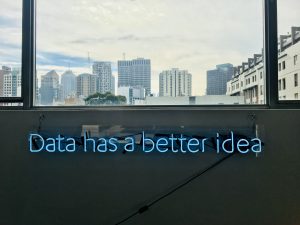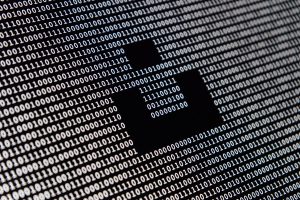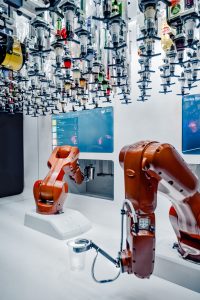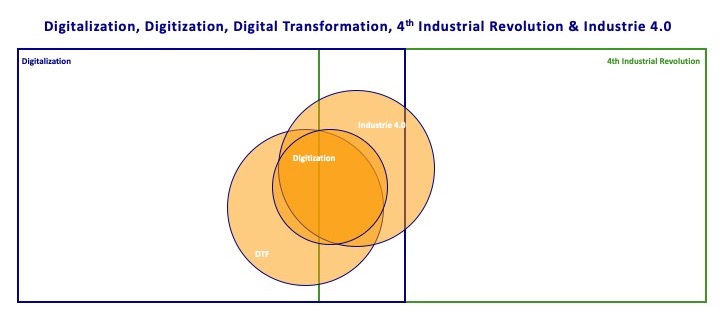Kevin Krause, University of Siegen, Research assistant at the chair of service development in SMEs and crafts
Contact: kevin.krause@uni-siegen.de
Abstract
Digitalization is currently a ubiquitous topic of discussion. It is entering our everyday life in the form of technologies that are indispensable. We also encounter it daily at the workplace. In the jungle of digital terminology, everyone has once or twice certainly lost their way. And this trend is not expected to come to an end; on the contrary, modern entrepreneurship continues to rely more and more on the integration of digital technologies and concepts. Entire business models are being restructured and the 4th industrial revolution was proclaimed in the course of digitalization. This trend poses a number of challenges for each of us. The most fundamental and almost banal is to understand what digitalization and the wave of other terms we encounter here mean. The following blog entry is dedicated to this challenge. In a two-part series, the phenomenon of digitalization will be explained in a clear and understandable way for everyone interested. In the first part the macro perspective of digitalization will be discussed. This includes concepts that are subsumed by digitalization and that summarize or subsume further components. This blog entry discusses three of the most prominent concepts: Digitization, Digital Transformation and Industry 4.0. By means of definition discussions and Venn diagrams the interfaces and differences of these concepts are illustrated and explained. At the end of the article a complete picture of these concepts and their interfaces in the context of digitalization is provided. In the second part of the series the concepts are extended by corresponding digital technologies. The aim of the overall series is to give a holistic impression of digitalization and the most prominent concepts and technologies.
Welcome to the jungle

In the jungle of digital terminology, even the most experienced experts get lost now and then between Industry 4.0, Digitization, Digital transformation (DTF), Internet of Things (IoT) or Services (IoS), Cyber Physical Systems (CPS), Artificial Intelligence (AI), Cloud Computing and even more. The variety of concepts, initiatives and technologies that are assigned to the collective term of digitalization is overwhelming in itself. Yet it is precisely these topics that should be made comprehensible to everyone due to the impact of digitalization on each and every one of us. Today the impact is greater than ever before, and it will continue to increase. Our future is digital. In order to be prepared for this future, a basic understanding of digitalization terminology is of fundamental importance. What is the point about all the trending words if they are not subject to a uniform understanding? Let’s clear up the mess…
What we (don’t) know
Digitalization is disrupting society economic, politically and socially today. The real story started in 1976 when Steve Jobs and Steve Wozniak brought the computer into the simple household. Prior to the invention of the Apple 1, the first personal computer (PC), computers have only been affordable for wealthy companies. A new era had dawned, in which the global economy was conquered by tech companies. Nowadays entrepreneurship is frequently associated with the founding of tech start-ups, or at least it can hardly be separated from digital technologies (Nambisan, 2017). Speaking of successful start-ups today, the so-called unicorns (Market valuation ≥ $1 billion; before IPO or exit) such as SpaceX, Airbnb, Uber or N26 are often mentioned as parade examples. Digital technologies form the core of the business model with which these companies have conquered the markets. For instance, the world’s largest passenger transport company Uber no longer owns vehicles but provides a peer to peer platform in order to coordinate unexploited resources. Companies try to follow the examples of revolutionary and disruptive tech companies and renew themselves according to them.
Next to the economic influence of technologies the heritage of the Apple 1 has also evolved into a variety of technologies that influence us personally like smartphones, wearables, smart TVs, house robots or full home automation systems, just to name a few. These technologies have conquered our daily life and the variety makes it hard to maintain the overview, even for the youngest generations. Apart from the invasion at home, for us the workplace has turned into a jungle of digitalization terminology. At work we are required to have a basic understanding of various digital concepts, initiatives or processes. The fundamental problem with this demand is the lack of common understanding of all these terms. So, why should we even bother to learn all this? Here comes the why…
Our future is digital

Digitalization determines our future life on many levels. For instance, the increase in efficiency along the value chain through digital technologies makes it impossible for companies to waive these technologies in a competitive market (Matt, Hess & Benlian, 2015). Hence, companies will inevitably focus on digitalization. The following statement underlines the importance of the inevitable confrontation between business and digitalization:
„Businesses that hope to survive into the next decade, or maybe even into next year, will have to remake themselves to accommodate this reality. But first, they have to understand it. That under- standing may be hampered by the proliferation of terms, some of them quite similar, around digital technology and digital innovation.“ (Gobble, 2018, p.56)
For us, this simply means that we will not get rid of all the digitalization terminology surrounding us at the workplace, on the contrary, it will increase. And also, the added value for our daily life, which is created by the use of these technologies, is indispensable. Whether it is cashless payment via apple pay or Near Field Communication (NFC), car navigation or chatting via smartphone, we depend on digital technology. But it is precisely this dependency that should motivate us to look at the whole concept of digitalization and aim for a comprehensive understanding. Otherwise one thing is certain, those who already lose the connection now will most probably not find it again in a changed digital world.
How to clean up the mess?
Fortunately, sharing information in the age of digitalization is simple and viral. So, you like everyone else who has been awakened, can lay the foundation for a holistic understanding of the concept of digitalization here. The following presents the first of a two-part analysis of digitalization terminology. The second part deepens the understanding of digitalization by explaining several digital technologies. The first part deals with the concepts and initiatives of digitalization whereas the most prominent ones: Digital Transformation, Digitization and the initiative Industry 4.0 will be discussed. Here we work towards an understanding of digitalization on the macro level. After discussing the definition of the individual concepts, they are separated from each other and put into relation. More concretely, we will develop a framework which shows the interrelations of the concepts towards each other and within the frame of digitalization by the means of Venn diagrams.

Digitization – Transforming information into a sequence of 0s and 1s

Let’s start with an easily cleared up confusion: the equivalence of Digitization and digitalization. Contrary to the frequently held opinion that these two terms are synonymous, Digitization goes back to a purely technical origin. Digitization is an important aspect of digitalization, which refers to the process of transferring information from the analogue- to the digital form. This process is characterized by a common understanding in literature. Authors agree on categorizing Digitization as a subset of digitalization. The technical component enables a clear distinction of what Digitization describes. The term was first defined by the Oxford English Dictionary (OED) in the mid 1950’s and is referred to as: „[…] the action or process of digitizing: the conversion of analogue data into digital form.“. Scott and Brennen (2016) explain in more detail, that the conversion refers to the act of translating analogue information into binary language. Gobble (2018) summarizes: „Digitization is the straightforward process of converting analog information to digital – turning pages into bytes […].“, (Gobble, 2018, p.12). Concludingly the distinction between Digitization and digitalization can be expressed as: „What Digitization doesn’t do is change the business itself; it doesn’t drive new business models or disrupt fundamental business strategies. That is the domain of digitalization.“, (Gobble, 2018, p.12). Hence, in economics digitalization affects the entire organization in multiple and complex ways while Digitization simply refers to the act of transforming information from analogue to digital form. Ross (2017) called Digitization an „operational necessity“ in contrast to digitalization which is in need of „a visionary digital value proposition [that offers] the opportunity to redefine a business – and possibly even an industry.“, (Ross, 2017, pp. 1).

From the society perspective, people barely get in contact with Digitization itself. Nevertheless, we use a lot of digitized information whenever we read on laptops, tablets or other technological devices. Therefore, Digitization covers an essential but tiny fraction of what we summarize under the term digitalization.
Digital Transformation – Companies in the digital age
Currently, there is no unified understanding of the term DTF (Schallmo, Rusnjak, Anzenbgruber, Werani & Jünger, 2017). A first step towards a consensus of understanding the topic is made by describing DTF and digitalization as separated subjects. Kollmann and Hensellek (2017) classify the DTF as an under section of digitalization. What we know is that the DTF describes some change within companies which is somehow related to digital technologies. Researchers agree that DTF enables the exploitation of technological advantages, expansion of the company’s market range, the increase of efficiency, customer benefits and the survival in a disruptive environment (Ott and Leyh, 2017; Schallmo et al., 2017). But also, the negative sides of digitalization like the existential threat of disruption has become reality to many organizations (Gobble, 2018).
However, researchers agree on the importance of DTF but disagree when it comes to setting up a definition. In order to understand the topic, it is important to look at the DTF on the one hand from the organizational perspective and on the other hand from the technological perspective. Both perspectives contain the same two elements: Organization and digital technologies, and differ in the weighting of these two elements.
The technological perspective

The technological perspective is represented by those who interpret the technology less as an initiator and more as a central element of the DTF. This perspective is characterized by a clear definition of the relevant digital technologies. For instance, Nwankpa and Roumani (2016) specify that within an enterprise, DTF is defined as an organizational shift to big data, analytics, cloud, mobile and social media platforms (Nwankpa & Roumani, 2016, p.2). Nwankpa and Roumani (2016) argue that the fundamental change, which is consistently identified by all researchers across disciplines and perspectives, equals the shift towards digital technologies. The exact naming of these technologies gives the whole thing a very limited framework. The definition would have to be extended with each technological innovation. Furthermore, the consequences of technological integration on the organization are not considered. Aspects such as staff training or changes to the business model are not considered. Similar to the confusion of Digitization and digitalization, digital technologies are a relevant part of the DTF but they do not represent the core element.
The organizational perspective

The look at the DTF from organizational perspective builds on the assumption that the central object to observe is an organization. The organization is experiencing a transformation process which is characterized by digital elements and their influence on the organization. Becker et al. (2018) found that the business model is innovated within the process of DTF. At the end of the process the innovated organization is characterized by a digital business model which is also referred to as data-driven organization (Teece, 2010; Zott & Amit, 2017; Pflaum & Schulz, 2018). For instance, Gobble (2018) states: „In digitalization, digitized data is the basis of knowledge that can be used to take action and generate change. And that process, allowed to grow and take root, leads to digital transformation […]”, (Gobble, 2018, p.6). Further the author defines DTF as the renewal of the entire business guided by the opportunities and chances linked to digital technologies (Gobble, 2018). Matt et al. (2015) categorize the elements of DTF into four essential dimensions which are: Use of technologies, changes in value creation, structural changes, and financial aspects (Matt et al., 2015, p.340). Klötzer and Pflaum (2015) identified that new information and communication systems (ICS‘) serve as a starting point of business model- and service-innovation. Accordingly, Becker et al. (2018) derive that: „[…] the drivers of DTF are, independent of the field of application, Innovations in the field of information and communication technologies.“, (Becker et al. 2018, p.61). This underlines that the technology perspective of the DTF has a right to exist as the initiator of the DTF, but must be subordinated to the organization in terms of relevance to the DTF concept itself. Kreutzer, Neugebauer and Pattloch (2017) see DTF as an economic trend of adapting processes, business models, services and products to a digital advancing environment.
To cut to the chase: researchers are still arguing over what exactly the term DTF describes. However, the organization has been widely accepted as a core element of the phenomenon. It is assumed that the organization as a whole is transformed in structure and processes, which leads to a new operative business model. Furthermore, technologies have been identified as initiators of the DTF. In summary, the DTF describes the way in which companies adapt their business modeto the new possibilities induced by digital technology. This leads to the conclusion that the DTF is a sub-category of digitalization, namely the part that describes the impact of digitalization on economic entities: the organizations.

The abuse of the number 4.0
Whether it is Work 4.0, Industry 4.0 or some other term in front of the mystic number, it is associated with a new era of society and economy.
The same association comes to the mind of many of us by the term digitalization, which sometimes leads to confusion. However, the number 4.0 is directly linked to the 4th industrial revolution we are experiencing right now (Hoffmann & Rüsch, 2017). Contrary to the common understanding the 4th industrial revolution does not equal digitalization and this is not the only confusion that occurs in this context.

The 4th industrial revolution
Let’s start with the 4th industrial revolution from which the number 4.0 is derived. Even though there is no agreement on how an industrial revolution is defined researchers agree that we have already experienced three of them. If one wants to emphasize a certain characteristic of the revolution, such as mechanization for the first-, mass production for the second- and automation for the third-industrial revolution, then in case 4.0 it would be the networking of digital, physical and biological technologies (Maynard, 2015).

In the context of networks, a lot of digital technologies and concepts form the basis of application and execution. This relationship is also the reason why many confuse digitalization and 4th industrial revolution. Parts of the digitalization are relevant aspects of the 4th industrial revolution but they do not equal each other. Consequently, one can say that the 4th industrial revolution represents the networking of machines and other entities in the economic context with intersections to digitalization topics such as digital technologies or concepts. Hoffmann and Rüsch (2017) define the 4th industrial revolution as:
„The 4th industrial revolution can be best described as a shift in the manufacturing logic towards an increasingly decentralized, self-regulating approach of value creation, enabled by concepts and technologies such as CPS [Cyber Physical Systems], IoT [Internet of Things], IoS [Internet of Services], cloud computing or additive manufacturing and smart factories, so as to help companies meet future production requirements.“ (Hoffmann & Rüsch, 2017, p.33)
So, back to the initial question. Where do all the 4s come from? Maybe the answer can be derived from one popular example: Industry 4.0. Is it the same like the industrial revolution, and if not where are the differences? Let’s take a look at it.
Industry 4.0
The initiative Industry 4.0 roots in the fact that Germany is well known for its strong manufacturing sector. As a response to changed economic circumstances the initiative was introduced in 2011 by the German National Academy of Science and Engineering to maintain this position on the long run (Kagermann, Wahlster & Helbig, 2013). Often Industry 4.0 is referred to as 4th industrial revolution, smart manufacturing, advanced manufacturing, industrial internet or integrated industry (Hofmann and Rüsch, 2017). In order to evaluate the correct use of these terms we have to understand what exactly Industry 4.0 is and what it is not.
Industry 4.0 is a strategy. The three elementary dimensions of the initiative are namely: “The horizontal integration across the entire value creation network, the end-to-end engineering across the entire product life cycle and the vertical integration and networked manufacturing systems”, (BITKOM e.V., VDMA e.V. und ZVEI e.V., 2015, p. 6). The first dimension the horizontal integration across the entire value creation network describes the externally as well as internally digitalized cooperation of companies/departments/customers in a value creation network. The: „[…] horizontal integration refers to the integration of the various IT systems used in the different stages of the manufacturing and business planning processes that involve an exchange of materials, energy and information both within a company (e.g. inbound logistics, production, outbound logistics, marketing) and between several different companies (value networks). The goal of this integration is to deliver an end-to-end solution.“ (Kagermann, Wahlster & Helbig, 2013, p.20). The cross-department or cross-company exchange is what the authors understand as integration.
The second dimension the end-to-end engineering across the entire product life cycle describes: „[…] the digital integration throughout the engineering process so that the digital and real worlds are integrated across a product’s entire value chain and across different companies whilst also incorporating customer requirements.“, (Kagermann, Wahlster & Helbig, 2013, p.31). This implicates that a company is able to serve its customers from the development of the value proposition to the use of the product/service itself until the final recycling – over the whole product life cycle.
The last dimension the vertical integration and networked manufacturing systems describes the internally digitalized cooperation of different hierarchical levels within a specific department. The:“[…] vertical integration refers to the integration of the various IT systems at the different hierarchical levels (e.g. the actuator and sensor, control, production management, manufacturing and execution and corporate planning levels) in order to deliver an end-to-end solution.“, (Kagermann, Wahlster & Helbig, 2013, p.20).
To put it in a nutshell, one can say that Industry 4.0 represents a high-tech strategy as answer to the 4th industrial revolution which fosters the idea of an integrated industry. It is therefore conclusive to state that that the 4th industrial revolution can be separated from the initiative Industry 4.0. While the revolution describes the economic shift towards the networking of machines and entities, Industry 4.0 poses the German answer towards these changed economic conditions (Maynard, 2015). This distinction also provides an explanation for the overuse of the number 4.0. Since the 4th industrial revolution is accompanied by disruptive changes in economy companies are forced to adapt to these changed conditions (Schuhmacher, Erol & Sinh, 2016). The resulting adaptation concepts are mainly named after the revolution that produced those concepts. Both, Industry 4.0 and the 4th industrial revolution have strong intersections with digitalization. Industry 4.0 includes various digital technologies and concepts as a part of the strategy to answer the new circumstances of the 4th industrial revolution. This revolution is due in large part to the progress of digitalization. However, since the 4th industrial revolution cannot be subordinated to digitalization as a whole, a second framework opens up (Fig.4, green frame). Industry 4.0 as a strategic response to these changes lies largely at the intersection of digitalization and the 4th Industrial Revolution.

The edges of the jigsaw
Combining all the Venn diagrams can be interpreted as finishing the edges of a jigsaw. You know your borders and the picture becomes a lot easier to create eventough you are not close to an end. So, if we now take a look at the concepts and how they are positioned to each other we have put us in perfect starting position to really understand digitalization from a macro perspective. Let’s connect the pieces.
All concepts are subordinated to digitalization, except for the 4th industrial revolution, which opens a new framework with an intersection to digitalization. The other topics have at least one element in common which is the digital technology. Hence all concepts have to overlap at least in one point which is somewhere located in the intersection of the two frames. This does not mean that the same technologies are relevant for all concepts, but that there are commonalities in the field of digital technologies. Consequently, we can connect Industry 4.0 and DTF and assume an overlap. This connection does not only include digital technologies, but also aspects such as vertical or horizontal integration (Industry 4.0), which can be part of a business model transformation (DTF). Modern entrepreneurship is currently flourishing in terms of new start-ups or internal projects, at the intersection of both. Topics such as the technology IoT are at the center of attention here.
However, the two concepts differentiate as Industry 4.0 focuses manufacturing and the DTF concentrates more on all non-sector-specific organizations. Therefore, besides the overlap they are still independent concepts. How does Digitization fit into this?
The conversion of data into digital form is one of the key steps of processing the DTF. We have seen that the data-driven organization based on digitized data is part of the overall picture of a DTF. Consequently, DTF & Digitization have a strong overlap. Furthermore, digitized data does also play a central role for the vertical and horizontal integration and the end to end engineering within Industry 4.0. This implies another strong connection of Digitization with Industry 4.0. We assumed that digital technologies are the centerpiece of overlap between Industry 4.0 and DTF. As Digitization does not frame more than the pure conversion of analogue to digital data, which is basically the roots of all technologies, it can be placed right in the middle of the overlap of Industry 4.0 and DTF. Since we know how controversial and disagreed the concepts are currently still being discussed, we allow for some leeway for Digitization. Illustrated by an overlap which belongs to the DTF but not to the Industry 4.0 and again exactly the other way around. In addition, we leave areas free at the intersection of DTF and Industry 4.0 that are not cut by Digitization. As already mentioned above, this is about common ground apart from digital technologies. If we now put all the pieces together, we will see the overall jigsaw of digitalization from a macro perspective as illustrated in Figure 5.

In conclusion, the following shall be said: Due to its scope and diversity, digitalization cannot yet be fully grasped. It will certainly be some years before a clear understanding of this phenomenon is achieved. Nevertheless, what we can already say today is:
Digitalization is a change that affects and changes our society in every form, whether economic, political or social. It was initiated by the Digitization of information using the binary code. This combination of 0 and 1 led to the groundbreaking technological innovations of our time, which forced companies to rethink and triggered the 4th industrial revolution. These new circumstances disrupt modern entrepreneurship and change the environment and operations of all companies. In response to these changes, the initiative Industry 4.0 was created and the concept of digital transformation identified with one goal in mind: To understand and make the most of the emerging possibilities of digitalization in a new age of entrepreneurship.
What is missing?
What we have not seen in more detail are the central elements that all these concepts have in common: Digital Technologies. In the second chapter of this blog entry you will find the most central and promising ones: Internet of Things, Cyber-Physical-Systems, Artificial Intelligence, Cloud Computing and Digital Twin. Read the next chapter and understand digitalization down to the micro level!
Keywords/SEO
Digitalization | Digitization | DTF | Digital | Industry 4.0 | 4th industrial revolution | 4.0
References
Amit, Raphael, and Christoph Zott. 2001. “Value Creation in E-Business.” Strategic Management Journal 22(6–7):493–520.
Becker, Wolfgang, Brigitte Eierle, Alexander Fliaster, Björn Ivens, Alexander Leischnig, Alexander Pflaum, and Eric Sucky, eds. 2019. Geschäftsmodelle in der digitalen Welt: Strategien, Prozesse und Praxiserfahrungen. Wiesbaden: Springer Fachmedien Wiesbaden.
BITKOM e.V., VDMA e.V. & ZVEI e.V. (2015). Plattform Industry 4.0 – Umsetzungsstrategie Industry 4.0 – Ergebnisbericht der Plattform Industry 4.0.
Klötzer, Christoph and Pflaum, Alexander. 2015. „Cyber-physical systems as the technical foundation for problem solutions in manufacturing, logistics and supply chain management,“ 2015 5th International Conference on the Internet of Things (IOT), Seoul, 2015, pp. 12-19.
D21 DIGITAL INDEX. 2018/2019 Jährliches Lagebild zur Digitalen Gesellschaft. Accessed via: https://initiatived21.de/app/uploads/2019/01/d21_index2018_2019.pdf (Accessed on: 12.02.2020)
Gimpel, Henner, and Maximilian Röglinger. 2015. “DIGITAL TRANSFORMATION.” 20.
Gläß, Rainer, and Bernd Leukert, eds. 2017. Handel 4.0: Die Digitalisierung Des Handels – Strategien, Technologien, Transformation. Berlin, Heidelberg: Springer Gabler.
Gobble, MaryAnne M. 2018. “Digitalization, Digitization, and Innovation.” Research-Technology Management 61(4):56–59.
Hess, Thomas, Matt, Christian, Benlian, Alexander & Wiesböck, Florian. (2016). Options for Formulating a Digital Transformation Strategy. MIS Quarterly Executive. 15. 123-139.
Hoffman, Brian J., Bethany H. Bynum, Ronald F. Piccolo, and Ashley W. Sutton. 2011. “Person-Organization Value Congruence: How Transformational Leaders Influence Work Group Effectiveness.” Academy of Management Journal 54(4):779–96.
Hoffmann, Erik, and Marco Rüsch. 2017. “Industry 4.0 and the Current Status as Well as Future Prospects on Logistics.” Computers in Industry 89:23–34.
Jensen, Klaus Bruhn, Eric Rothenbuhler, Jeff Pooley, and Robert T. Craig, eds. 2016. The International Encyclopedia of Communication Theory and Philosophy. Hoboken, NJ, USA: John Wiley & Sons, Inc.
Kagermann, Henning, Wahlster, Wolfgang & Helbig, Johannes. (2013). Securing the future of German manufacturing indus- try – Recommendations for implementing the strategic initiative INDUSTRY 4.0. Accessed via: https://www.din.de/blob/76902/e8cac883f42bf28536e7e8165993f1fd/recommendati ons-for-implementing-industry-4-0-data.pdf (Accessed on: 12.08.2019)
Kaufmann, Timothy. 2015. Geschäftsmodelle in Industry 4.0 und dem Internet der Dinge. Wiesbaden: Springer Fachmedien Wiesbaden.
Kollmann Tobias, Hensellek, Simon. (2017) Die Basisarchitektur digitaler Geschäftsmodelle. In: Gläß R., Leukert B. (eds) Handel 4.0. Springer Gabler, Berlin, Heidelberg
Kreutzer, Ralf T., Tim Neugebauer, and Annette Pattloch. 2017. Digital Business Leadership. Wiesbaden: Springer Fachmedien Wiesbaden.
Kugler, Sascha, and Felix Anrich. 2018. Digitale Transformation im Mittelstand mit System: Wie KMU durch eine innovative Kultur den digitalen Wandel schaffen. Wiesbaden: Springer Fachmedien Wiesbaden.
Matt, Christian, Thomas Hess, and Alexander Benlian. 2015a. “Digital Transformation Strategies.” Business & Information Systems Engineering 57(5):339–43.
Nambisan, Satish. 2017. “Digital Entrepreneurship: Toward a Digital Technology Perspective of Entrepreneurship.” Entrepreneurship Theory and Practice 41(6):1029–55.
Nwankpa, Joseph K., and Yaman Roumani. n.d. “IT Capability and Digital Transformation: A Firm Performance Perspective.” 16.
Ott, Marko, Christian Leyh, and TU Dresden. n.d. “Digitalisierung in kleinen und mittleren Unternehmen.” Digitale Transformation 5.
Pflaum, Alexander, and Esther Schulz. 2018. “Auf dem Weg zum digitalen Geschäftsmodell: „Tour de Force“ von der Vision des digitalisierten Unternehmens zum disruptiven Potenzial digitaler Plattformen.” HMD Praxis der Wirtschaftsinformatik 55(2):234–51.
Ross, Jeanne. n.d. “Donʼt Confuse Digital With Digitization.” 5.
Schallmo, Daniel, Andreas Rusnjak, Johanna Anzengruber, Thomas Werani, and Michael Jünger, eds. 2017. Digitale Transformation von Geschäftsmodellen: Grundlagen, Instrumente und Best Practices. Wiesbaden: Springer Fachmedien Wiesbaden.
Schumacher, Andreas, Selim Erol, and Wilfried Sihn. 2016. “A Maturity Model for Assessing Industry 4.0 Readiness and Maturity of Manufacturing Enterprises.” Procedia CIRP 52:161–66.
Teece, David J. 2010. “Business Models, Business Strategy and Innovation.” Long Range Planning 43(2–3):172–94.
World Economic Forum (2016). Digital Transformation of Industrys. Accessed via: http://re- ports.weforum.org/digital-transformation/wp-con- tent/blogs.dir/94/mp/files/pages/files/wef1601-digitaltransformation-1401.pdf (Accessed on: 21.08.2019)
Zott, Christoph, and Raphael Amit. 2017. “Business Model Innovation: How to Create Value in a Digital World.” GfK Marketing Intelligence Review 9(1):18–23.
